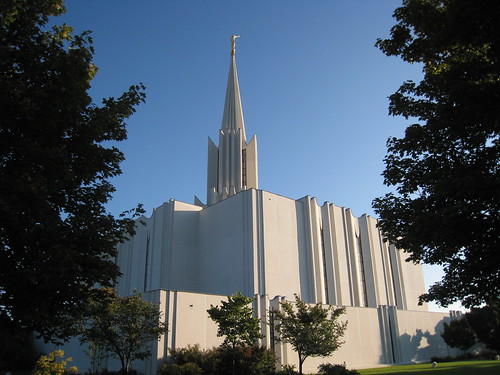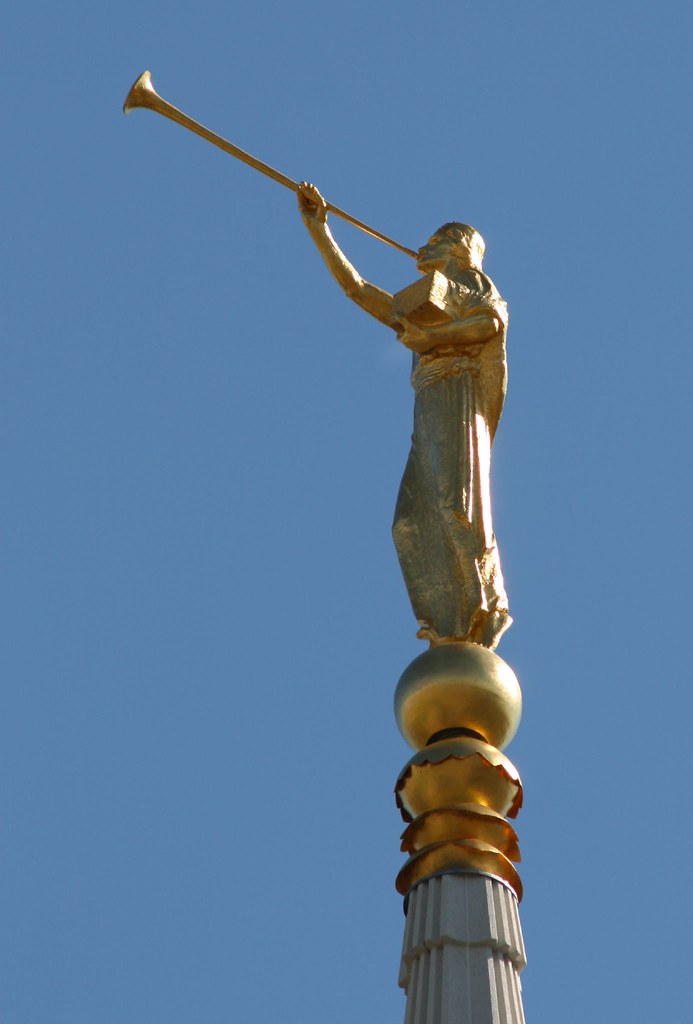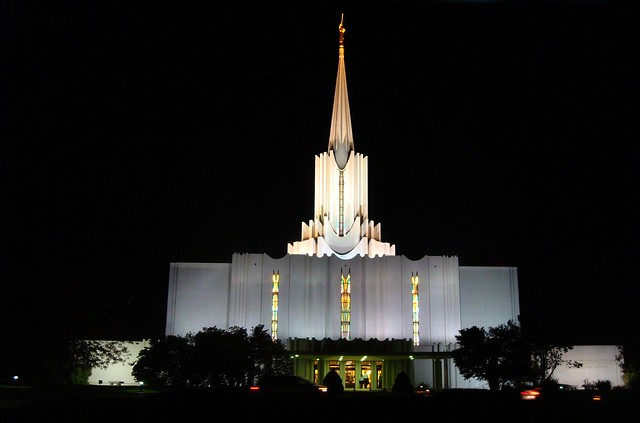 |
| Jordan River Utah Temple |
 |
| The Jordan River Utah Temple |
The Exterior
 |
| Angel Moroni Statue |
The architecture of this temple is a modern 1980s style. The exterior is made of white cast stone (precast concrete panels) with white marble chips. These panels have a repeated inverted swoop theme which is also used as the main decorative motif in this temple. These swoops (inverted parabolic arches?) are generally displayed in threes.
The temple tower is actually made of fiberglass which significantly reduces the weight on the structure below and reduces the mass of the building to reduce the seismic loads on the structure. Despite being a different material, it blends perfectly with the cast stone.
 |
| The Jordan River Utah Temple at night |
The temple has a lot of symmetry, with each of the four sides being nearly identical. This makes the temple approachable from all directions.
The exterior and interior of this temple is very light on symbolism with the Angel Moroni statue on the spire and oxen statues supporting the font being the only prominent symbols.
The Interior
 |
| Jordan River Temple Font |
The bottom floor of the temple also has worker training rooms and a cafeteria. The cafeteria is good, although the smell of food does drift into the baptistry where it is distracting.
The first floor of the temple houses the temple offices, a lobby, and dressing rooms. The lobby was redone sometime around 2005 with new lights, stone flooring, etc. and is really nice. There is a huge painting of the Garden of Eden (essentially copied from the L.A. Temple garden room mural) on one wall.
The Jordan River Utah Temple is one of the few temples with escalators. They aren't as bad as you might think. While I would welcome actual stairs, the escalators work well, are fairly quiet, and provide good views of the stained glass windows.
The second floor contains the chapel and the sealing rooms. The chapel has some dark wood, but not annoyingly so. It has an electronic organ. In front of the speakers are dark wood posts that give the feel of pipes (while clearly being just decorative). These have the same swooping pattern found elsewhere on the temple. They look really cool, but are hard to describe, so you'll just have to see them for yourself.
 |
| Sealing Room |
The endowment rooms and celestial rooms are on the third floor of the temple. There are six endowment rooms and the Jordan River Temple is one of only 4 temples with this many endowment rooms. I am fairly sure that the endowment rooms in the Jordan River Temple are larger than the other temples making this the temple with the highest capacity. Even with sessions starting every 20 minutes, this temple is kept busy. The endowment rooms are fairly simple. Their walls have alternating vertical strips or wallpaper and wood paneling with brass swoops matching the swoops elsewhere in the temple. The altars are made of stone and match those in the sealing rooms. The rooms can seat around 125-150 (If I remember correctly) and feel very spacious. They also have high ceilings.
 |
| Jordan River Temple Celestial Room |
The third floor hallways also contain nice artwork - mainly landscapes. The halls also provide views of the stained glass windows.
Throughout the temple there are also specially sculpted doorknobs. These are brass or bronze and have swoops and other shapes that echo the architecture and patterns common in this temple. It is nice seeing custom handles to make the temple a special place.
The Jordan River Utah Temple is a great example of 1980s modern architecture in my opinion. It has beautiful repeated patterns, clean lines, and great functionality. It does lack much symbolism, but I suppose it is okay for a few temples to be this way. I love this temple and am glad we have it.
One of the best parts of the Jordan River Temple has nothing to do with the architecture, but rather how it is run. The temple (at least when I worked there) went to great efforts to make patrons feel comfortable. It is always a friendly place and among the best in that regard.
Those are some of my thought on this temple. Please comment and let us know what you think about this temple.